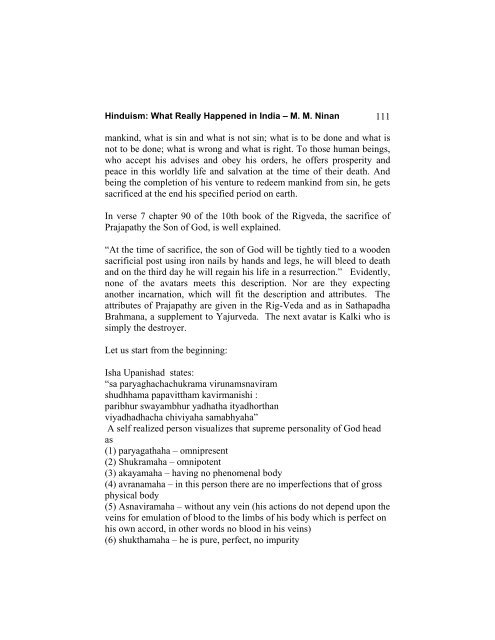Hinduism: What Really Happenned in India (PDF) - Oration
Hinduism: What Really Happenned in India (PDF) - Oration
Hinduism: What Really Happenned in India (PDF) - Oration
Create successful ePaper yourself
Turn your PDF publications into a flip-book with our unique Google optimized e-Paper software.
<strong>H<strong>in</strong>duism</strong>: <strong>What</strong> <strong>Really</strong> Happened <strong>in</strong> <strong>India</strong> – M. M. N<strong>in</strong>an<br />
111<br />
mank<strong>in</strong>d, what is s<strong>in</strong> and what is not s<strong>in</strong>; what is to be done and what is<br />
not to be done; what is wrong and what is right. To those human be<strong>in</strong>gs,<br />
who accept his advises and obey his orders, he offers prosperity and<br />
peace <strong>in</strong> this worldly life and salvation at the time of their death. And<br />
be<strong>in</strong>g the completion of his venture to redeem mank<strong>in</strong>d from s<strong>in</strong>, he gets<br />
sacrificed at the end his specified period on earth.<br />
In verse 7 chapter 90 of the 10th book of the Rigveda, the sacrifice of<br />
Prajapathy the Son of God, is well expla<strong>in</strong>ed.<br />
“At the time of sacrifice, the son of God will be tightly tied to a wooden<br />
sacrificial post us<strong>in</strong>g iron nails by hands and legs, he will bleed to death<br />
and on the third day he will rega<strong>in</strong> his life <strong>in</strong> a resurrection.” Evidently,<br />
none of the avatars meets this description. Nor are they expect<strong>in</strong>g<br />
another <strong>in</strong>carnation, which will fit the description and attributes. The<br />
attributes of Prajapathy are given <strong>in</strong> the Rig-Veda and as <strong>in</strong> Sathapadha<br />
Brahmana, a supplement to Yajurveda. The next avatar is Kalki who is<br />
simply the destroyer.<br />
Let us start from the beg<strong>in</strong>n<strong>in</strong>g:<br />
Isha Upanishad states:<br />
“sa paryaghachachukrama virunamsnaviram<br />
shudhhama papavittham kavirmanishi :<br />
paribhur swayambhur yadhatha ityadhorthan<br />
viyadhadhacha chiviyaha samabhyaha”<br />
A self realized person visualizes that supreme personality of God head<br />
as<br />
(1) paryagathaha – omnipresent<br />
(2) Shukramaha – omnipotent<br />
(3) akayamaha – hav<strong>in</strong>g no phenomenal body<br />
(4) avranamaha – <strong>in</strong> this person there are no imperfections that of gross<br />
physical body<br />
(5) Asnaviramaha – without any ve<strong>in</strong> (his actions do not depend upon the<br />
ve<strong>in</strong>s for emulation of blood to the limbs of his body which is perfect on<br />
his own accord, <strong>in</strong> other words no blood <strong>in</strong> his ve<strong>in</strong>s)<br />
(6) shukthamaha – he is pure, perfect, no impurity



